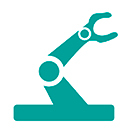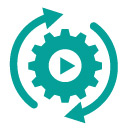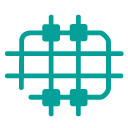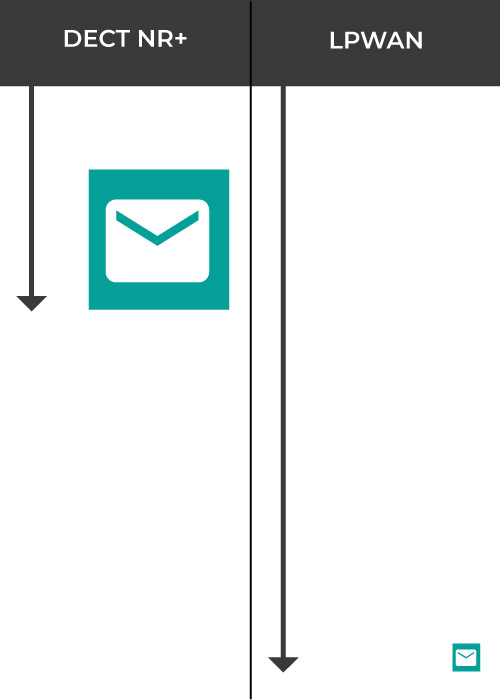What is DECT NR+
DECT NR+ (Digital Enhanced Cordless Telecommunications New Radio) is a new type of non-cellular radio standard that is part of the 5G standards This technology is particularly suitable for massive IoT applications and offers extremely reliable, low-latency communication DECT NR+ uses the worldwide licence-free 1.9 GHz band and enables the operation of private networks without frequency planning or spectrum leasing costs.
Typical areas of application for DECT NR+

Industrial IoT (IIoT)
Monitoring systems and machines

Smart City
Street lighting, traffic tracking and other remote monitoring systems

Automation
Optimisation of processes in production and warehouse
Supply Chain Management
Logistical monitoring of goods and vehicles

Smart Grid
Optimisation of energy distribution and energy use
Building digitalisation
Control and monitoring of HVAC systems and energy management
DECT NR+ compared to other technologies
DECT NR+ fills a specific niche in the world of IoT technologies, especially when compared to other wireless technologies such as LTE-M, NB-IoT and LoRa. While these technologies focus on specific applications or work with frequencies that require a licence, DECT NR+ offers a licence-free, robust and cost-effective solution for massive IoT networks that require high device density and low latency. Its main advantage lies in the higher data rate, which enables other areas of application.

DECT NR+ vs. LPWAN - what's the difference?
Frequency range and coverage: DECT NR+ uses the 1.9 GHz band, which is licence-free in most parts of the world. It is ideal for dense, urban environments and supports network topologies that require a high data transmission rate. LPWAN technologies often operate in different frequency bands, including 868 MHz in Europe and 915 MHz in North America. They are known for their ability to span long distances, often several kilometres, making them ideal for rural or industrial applications where devices are widely dispersed.
Energy consumption and data rate: DECT NR+ offers efficient energy consumption with a high data transmission rate. This makes the technology suitable for fast reactions and data updates, such as in industrial automation processes. LPWAN, on the other hand, is extremely energy-efficient and designed for applications that require low data rates and where end devices often only send data sporadically.
Areas of application: DECT NR+ is particularly suitable for private networks and applications that require a high device density and low delays, such as in smart factories or urban environments. In addition, if the transmitted data is more extensive, image files can also be transmitted.
Overall, DECT NR+ and LPWAN offer different strengths that make them suitable for specific use cases within the IoT spectrum. DECT NR+ offers higher data rates and improved network control, making it ideal for industrial and urban applications, while LPWAN is designed to maximise range and energy efficiency for simpler tasks such as monitoring and reporting sensor data.Is DECT NR+ the right technology for you?
Feel free to contact us if you would like to discuss your specific application conditions and find out which IoT technology is best suited to your requirements.
Limitations of DECT NR+ technology
Frequency band and interference: DECT NR+ uses the 1.9 GHz band, which is licence-free in most parts of the world. However, this band is also used by other services, which can lead to potential interference, especially in densely populated or industrialised areas. As a relatively new technology, DECT NR+ may still be experiencing some teething problems or may still lack extensive real-world deployment data.
Range: Although DECT NR+ offers good coverage inside buildings, its range is limited compared to some other wireless technologies that use lower frequencies. This can lead to limitations, especially in rural or wide-open areas.
Complexity of network management: DECT NR+ supports complex network topologies that enable efficient and flexible data transmission. However, managing such networks can be complex and may require advanced technical knowledge and resources for network monitoring and maintenance. This could be a hurdle for smaller organisations or applications where cost is a critical factor.
Energy consumption: Despite advanced power management features, the energy consumption of DECT NR+ can be higher than other low-power IoT technologies such as LoRaWAN or NB-IoT in some use cases, especially when high data rates or frequent transmissions are required.


